Curiosity of Plant Galls:
Explaining the unusual gall growths or deformities in plants can be challenging. Different galls can be found on virtually any plant part, including leaves, flowers, twigs, bark, or buds of trees and shrubs. Galls caused by insects or mites can typically be identified by the characteristic size, shape, color, and structure that develops.
Insect/mite galls are produced by the interaction of plant hormones with strong plant-regulating chemicals released by the gall maker as they feed. The immature larvae live their entire lives within an individual gall, which provides excellent protection for the larvae as they feed and mature.
This blog contains information on horned and gouty oak galls. When the number of galls infesting an oak is few, tree damage is insignificant. However, tree injuries become more severe when gall numbers reach high levels.
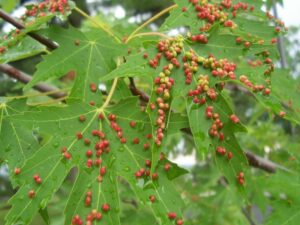
Curious & colorful leaf galls created by maple bladder galls mites may cause alarm to some people but they are mostly harmless. (Photo Credit: Steven K. Rettke, Rutgers Coop. Ext.)
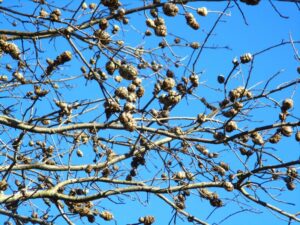
An extreme infestation of horned oak galls on branches of pin oak tree. (Photo Credit: Steven K. Rettke, Rutgers Coop. Ext.)
Two Exceptions to the Rule:
Although most plant galls are not aesthetically pleasing, usually they are only a curiosity & not a plant health concern. Two examples of exceptions to the rule are the woody stem galls called horned oak galls (Callirhytis cornigera) & gouty oak galls (Callirhytis quercuspunctata). These wasp gall species can occasionally reach outbreak levels & cause tree damage.
The growth of these galls is initially stimulated when adult females inject eggs & chemicals into stem cambial tissue. This forces undifferentiated plant cells to grow abnormally. Hatched larvae continue to release chemical plant growth regulators to further direct gall growth. After a few years, large galls up to two inches in diameter can encircle branches which can inhibit & disrupt the vascular flow of water & nutrients. This can eventually result in individual branch dieback & tree canopy decline when galls build up & reach large numbers. Although the death of oaks is unlikely, when infestations are severe then tree removal may be desired.
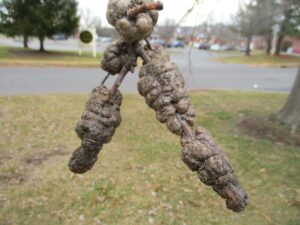
Large mass of many gouty oak galls growing tightly together & encircling these branches. (Photo Credit: Steven K. Rettke, Rutgers Coop. Ext.)
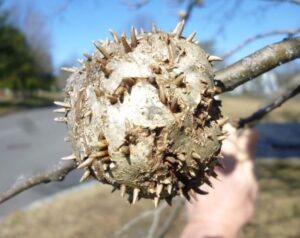
Large horned oak gall with many emergence horns by adult wasps. Many of the larger galls can contain over one hundred wasp larvae feeding within. (Photo Credit: Steven K. Rettke, Rutgers Coop. Ext.)
Oak Species Hosts:
Both oak gall wasp species are native to the east coast & mid-west US states. The hosts each gall species feeds upon will sometimes differ. Both feed on red oak group species but the horned oak gall will most typically be found on pin, scrub, blackjack, and water oaks. On the other hand, gouty oak galls generally attack pin, scarlet, red, and black oaks. Pin oaks are especially susceptible to infestations by both stem galls.
Once gall wasps target a specific tree, the trend will often continue and increase over the years. However, for unknown reasons, some individual oak trees have resistance and are less susceptible to gall build-up.
Complex Life Cycles:
Both stem galls have two generations that when added together take 3-years to complete their life cycles. Each generation completes its life cycle in two different plant parts. The 1st occurs in the leaves & requires 3 months to complete while the 2nd occurs in young branch stems & requires an additional 33 months. This alternation of generations with two different reproductive modes is known as heterogamy. Research has shown it is difficult to manage these stem galls that have alternate generations.
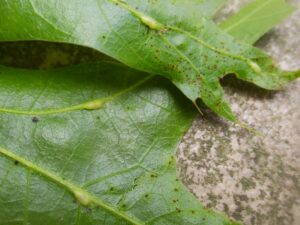
Leaf galls of the 1st generation horned oak galls. They form along leaf veins on the leaf undersides. They take 3 months to develop as larvae. (Photo Credit: Steven K. Rettke, Rutgers Coop. Ext.)
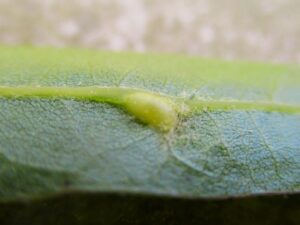
Close up of the horned oak gall 1st generation leaf gall stage. Adult wasps exit the leaf after 3 months of development during summer (>1500 GDDs). (Photo Credit: Steven K. Rettke, Rutgers Coop. Ext.)
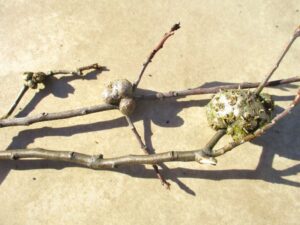
The horned oak gall at far right is 33 months old compared to the smaller galls at the left that are 26 months or younger. (Photo Credit: Steven K. Rettke, Rutgers Coop. Ext.)
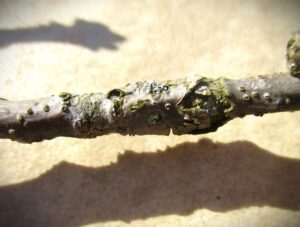
Horned oak galls on stem at 10 months old during 2nd generation stage. These younger larvae only initially cause the stems to swell slightly. (Photo Credit: Steven K. Rettke, Rutgers Coop. Ext.)
Life Cycle Specifics:
The different life cycles between the horned oak gall vs. gouty oak gall wasp species are so similar that they are often viewed as the same. Only adult female wasps emerge (parthenogenic or no mating type of reproduction) in May (~270 GDDs) from old woody stem galls or when new leaf buds begin to swell & expand. They are weak fliers & often crawl to lay eggs in leaf buds that may just be starting to swell. These 1st generation leaf galls that develop are formed along leaf veins. Wasp larvae in leaf veins require about 3 months to develop. Both male & female wasps emerge (sexual generation) from leaf vein galls in July (>1500 GDDs). These wasps are stronger fliers & after mating they will fly to lay eggs into young twigs. The 2nd generation twig galls then grow & enlarge for 33 months. The eventual size reached by an individual gall is dependent on the number of larvae present. The largest gall sizes that develop may contain as many as 160 wasp larvae.
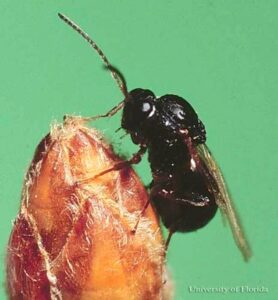
During the spring, the adult wasps emerge from the large stem galls after 33 months & crawl to leaf buds to deposit eggs. (Photo Credit: U. of FL)
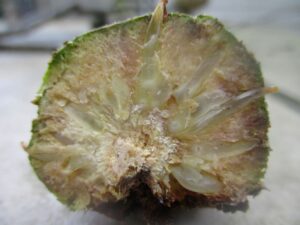
Horned oak gall cross section cut-a-way showing emerged hollow exit horns. The tunnels provide easy access to the surface for adult wasps. (Photo Credit: Steven K. Rettke, Rutgers Coop. Ext.)
The major difference between the horned oak gall & the gouty oak gall is the sprouting of hollow horns that elongate from the gall surface of the horned oak gall. As the larvae begin to reach pupation, the horns are stimulated to rise from deep within the center of the gall. This allows an easy exit pathway for the female adults to emerge from the gall. Alternatively, the gouty oak gall females must chew their exit holes to emerge from the gall surface. Counting the horns or holes on the gall surface indicates the number of wasp larvae that developed within an individual gall.
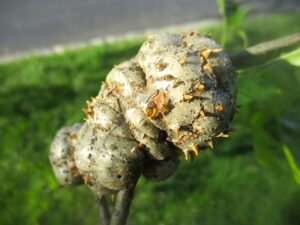
In the spring the mature galls begin to show the early emergence of horns on the gall surface (~270 GDDs). Most horns will become fully extended in only a day or two. (Photo Credit: Steven K. Rettke, Rutgers Coop. Ext.)
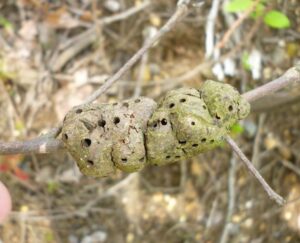
Gouty oak galls have no hollow horns but only holes on surface as adult wasps emerge from galls (~270 GDDs). Both gall species have similar life cycles. (Photo Credit: Steven K. Rettke, Rutgers Coop. Ext.)
Managing Oak Galls: Pruning:
The complicated life cycles of each of the galls make controls difficult. Most control recommendations merely call for the pruning out of the larger maturing stem galls before adults emerge in the spring. This is problematic when often many galls are growing within the upper canopy of large trees. Also, it becomes impractical when large numbers of galls are present. Furthermore, because of the alternating life cycle, this control strategy only partially manages this pest. It will require multiple years of pruning before control may start to be achieved & will best be accomplished on smaller trees. Pruning out old spent galls already having exit holes provides no controls. However, the old galls can remain attached for years affecting a tree’s aesthetic value.
Once the adults have exited the galls, future generations of gouty or horned oak galls will not use them further. However, research has shown beneficial insects (e.g., parasitoids) can utilize old galls after the original gall makers have emerged.
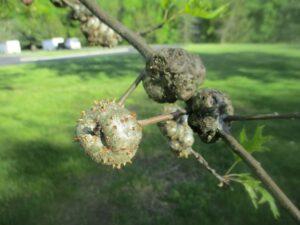
Horned oak gall at left is a 33 month old gall showing recent emergence horns by wasps. The two older galls on the right have long been inactive & are beginning to show deterioration. They can mar the aesthetic appearance of the tree. (Photo Credit: Steven K. Rettke, Rutgers Coop. Ext.)
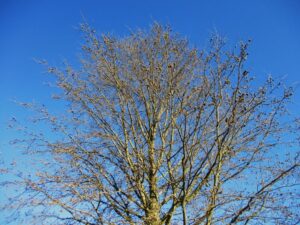
A large, tall pin oak tree showing heavy horned oak gall infestations at the top of the canopy. Extreme infestations can begin to kill branches. (Photo Credit: Steven K. Rettke, Rutgers Coop. Ext.)
Managing Oak Galls: Sprays & Injections:
One of the most definitive research studies of oak stem gall controls was made more than 25 years ago at the University of Kentucky by Eileen Eliason & Dan Potter. (ref: Eliason & Potter, J Arboriculture 27: 2001; 92-100).
This comprehensive study was performed along farm roads on a horse farm with more than 200 heavily infested pin oak trees. The research sought to determine the optimal treatment timing using both insecticide canopy sprays & trunk injection treatments against both the leaf & stem generations of horned oak gall wasps. Results showed that spraying the canopy with insecticides when the adults were emerging from stem galls in the spring did not ultimately reduce the number of stem galls formed by the next generation, compared to the control. Furthermore, none of the trunk injections significantly reduced the number of galled leaves nor the new stem galls either. As things stand now, there is no scientific insecticide efficacy data available that shows contact or systemic chemical controls to be dependable. Anecdotal testimony has stated that trunk injections using Bidrin (Dicrotophos) insecticide over 4 consecutive years have shown results (Bidrin is a restricted-use material having a Danger label). “Anecdotal accounts of suppressing gall formation using canopy sprays or soil drenches/tree injections should be viewed with skepticism.” (Dr. Joe Boggs, Entomologist, Ohio State Coop. Ext.)
The Bottom Line:
The research concluded that parasitism was the primary means of natural control of these galls, with 7 different parasitic wasp species found. Parasitism accounted for over 67% control of gall makers. The sprays applied at bud break probably do not affect parasitoids, but the injections/drenches will significantly harm them.
Although not confirmed with scientific research studies, if this pest is to be at least partially suppressed, it may be possible that multiple years of treatments along with pruning could potentially give somewhat acceptable results. However, confidence should not be high, especially with large heavily infested trees. Overall, the Kentucky research at least gives some insight into the difficulties in managing a pest with alternate generations.
References:
Eliason, EA, and Potter, DA. 2001. “Biology and Management of Horned Oak Gall Wasp on Pin Oak.” J Arboriculture 27: 92-100.
Boggs, Joe. “Horned Oak Galls Pop.” Ohio Buckeye Garden Line, May 3, 2018.
Smith-Fiola, Deborah. “Managing Oak Galls.” Rutgers Landscape IPM Notes, May 2001.

